An In Vitro–In Vivo Comparison of Two Levodopa Dry Powder Products for Inhalation: A Randomized Trial Comparing Inbrija and Levodopa Cyclops
Abstract
1. Introduction
2. Materials and Methods
2.1. Materials
2.2. In Vitro Characterization
2.2.1. Content Analysis
2.2.2. Aerosol Characterization
2.2.3. Dissolution
2.3. In Vivo Comparative Bioavailability Study
2.3.1. Design, Participants, and Selection Criteria
2.3.2. Study Procedures and Medication
2.3.3. Objectives and Pharmacokinetic Analysis
2.3.4. Statistics
3. Results
3.1. In Vitro Characterization
3.1.1. Aerosol Characterization
3.1.2. Dissolution
3.2. In Vivo Comparative Bioavailability Study
3.2.1. Demographics
3.2.2. Pharmacokinetics
3.2.3. Safety and Tolerability
4. Discussion
Author Contributions
Funding
Institutional Review Board Statement
Informed Consent Statement
Data Availability Statement
Conflicts of Interest
Abbreviations
| DPI | Dry powder for inhalation |
| NGI | Next generation impactor |
| OIDP | Orally inhaled drug product |
| Cmax | Maximum plasma concentration |
| Tmax | Time to maximum plasma concentration |
| AUC0–4 | Area under plasma concentration-time curve from zero to four hours post-dose |
| AUC0–t | Area under the plasma concentration-time curve from zero to the last observed concentration |
| AUC0–∞ | Area under plasma concentration-time curve from zero to infinity |
| t1/2 | Plasma concentration half-life |
| SD | Standard deviation |
Appendix A
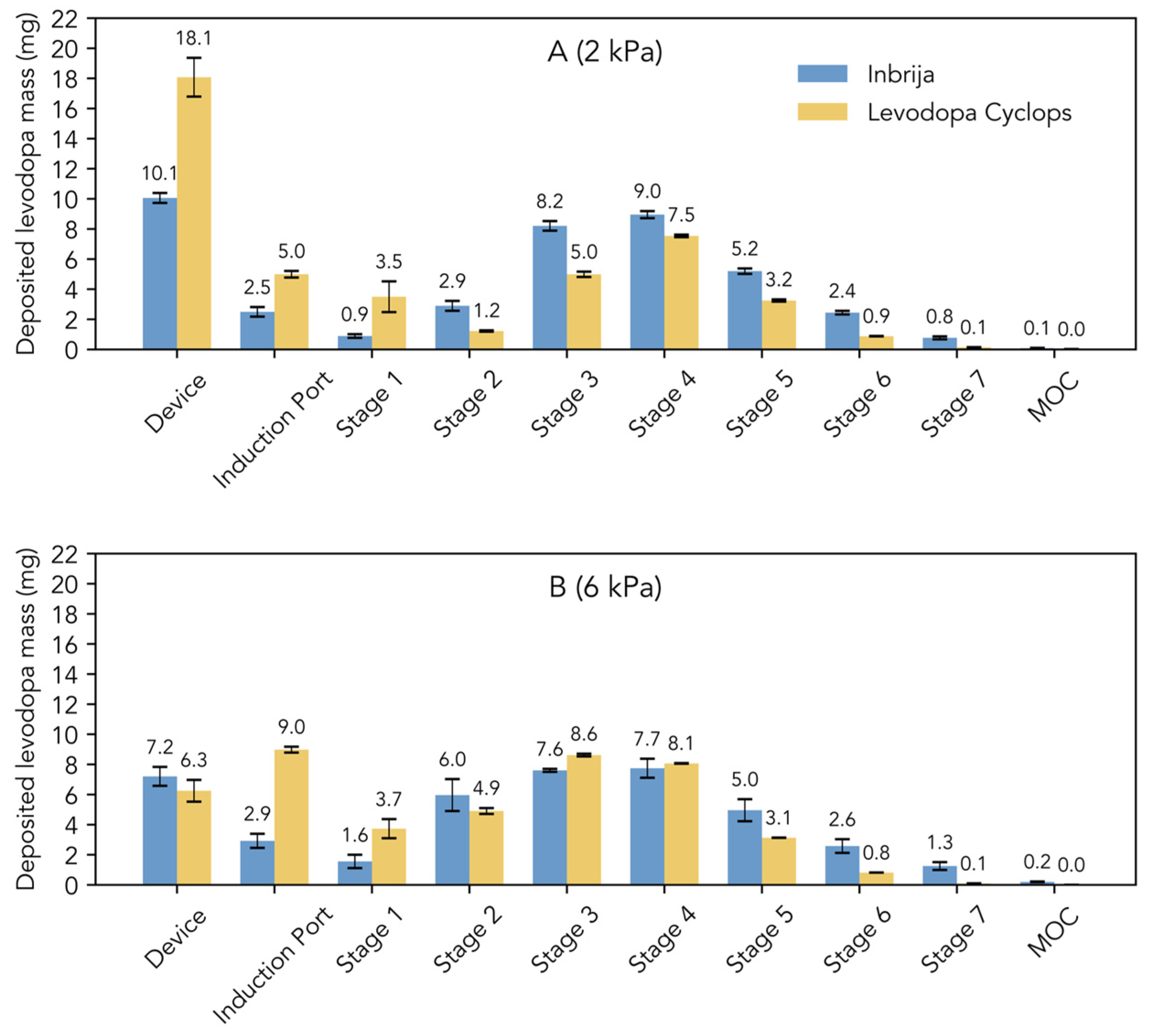
References
- Zafar, S.; Yaddanapudi, S. Parkinson Disease. In StatPearls [Internet]; StatPearls Publishing: Treasure Island, FL, USA, 2023. Available online: https://www.ncbi.nlm.nih.gov/books/NBK470193/ (accessed on 18 February 2025).
- Ahlskog, J.E.; Muenter, M.D. Frequency of levodopa-related dyskinesias and motor fluctuations as estimated from the cumulative literature. Mov. Disord. 2001, 16, 448–458. [Google Scholar] [CrossRef]
- Stocchi, F.; Antonini, A.; Barone, P.; Tinazzi, M.; Zappia, M.; Onofrj, M.; Ruggieri, S.; Morgante, L.; Bonuccelli, U.; Lopiano, L.; et al. Early detection of wearing off in Parkinson Disease: The DEEP study. Park. Relat. Disord. 2014, 20, 204–211. [Google Scholar] [CrossRef]
- Safirstein, B.E.; Ellenbogen, A.; Zhao, P.; Henney, H.R., 3rd; Kegler-Ebo, D.M.; Oh, C. Pharmacokinetics of inhaled levodopa administered with oral carbidopa in the fed state in patients with Parkinson’s Disease. Clin. Ther. 2020, 42, 1034–1046. [Google Scholar] [CrossRef] [PubMed]
- Lipp, M.M.; Batycky, R.; Moore, J.; Leinonen, M.; Freed, M.I. Preclinical and clinical assessment of inhaled levodopa for OFF episodes in Parkinson’s disease. Sci. Transl. Med. 2016, 8, 360ra136. [Google Scholar] [CrossRef] [PubMed]
- LeWitt, P.A.; Hauser, R.A.; Pahwa, R.; Isaacson, S.H.; Fernandez, H.H.; Lew, M.; Saint-Hilaire, M.; Pourcher, E.; Lopez-Manzanares, L.; Waters, C.; et al. Safety and efficacy of CVT-301 (levodopa inhalation powder) on motor function during off periods in patients with Parkinson’s Disease: A randomised, double-blind, placebo-controlled phase 3 trial. Lancet Neurol. 2019, 18, 145–154. [Google Scholar] [CrossRef] [PubMed]
- LeWitt, P.A.; Hauser, R.A.; Grosset, D.G.; Stocchi, F.; Saint-Hilaire, M.H.; Ellenbogen, A.; Leinonen, M.; Hampson, N.B.; DeFeo-Fraulini, T.; Freed, M.I.; et al. A randomized trial of inhaled levodopa (CVT-301) for motor fluctuations in Parkinson’s Disease. Mov. Disord. 2016, 31, 1356–1365. [Google Scholar] [CrossRef]
- OINDPnews. FDA Approves Inbrija Inhaled Levodopa for the Treatment of Parkinson’s Disease. Available online: https://www.oindpnews.com/2018/12/fda-approves-inbrija-inhaled-levodopa-for-the-treatment-of-parkinsons-disease/ (accessed on 3 April 2025).
- OINDPnews. CHMP Issues Positive Opinion Regarding Inbrija. Available online: https://www.oindpnews.com/2019/07/chmp-issues-positive-opinion-regarding-inbrija/ (accessed on 3 April 2025).
- Nakanishi, Y.; Iwamoto, H.; Miyamoto, S.; Nakao, S.; Higaki, N.; Yamaguchi, K.; Sakamoto, S.; Horimasu, Y.; Masuda, T.; Matsumoto, N.; et al. Association between patient preference for inhaler medications and asthma outcomes. J. Asthma Allergy 2022, 15, 1539–1547. [Google Scholar] [CrossRef]
- Plaza, V.; Giner, J.; Calle, M.; Rytilä, P.; Campo, C.; Ribó, P.; Valero, A. Impact of patient satisfaction with his or her inhaler on adherence and asthma control. Allergy Asthma Proc. 2018, 39, 437–444. [Google Scholar] [CrossRef]
- Price, D.; Harrow, B.; Small, M.; Pike, J.; Higgins, V. Establishing the relationship of inhaler satisfaction, treatment adherence, and patient outcomes: A prospective, real-world, cross-sectional survey of US adult asthma patients and physicians. World Allergy Organ. J. 2015, 8, 26. [Google Scholar] [CrossRef]
- Luinstra, M.; Grasmeijer, F.; Hagedoorn, P.; Moes, J.R.; Frijlink, H.W.; de Boer, A.H. A levodopa dry powder inhaler for the treatment of Parkinson’s Disease patients in OFF periods. Eur. J. Pharm. Biopharm. 2015, 97, 22–29. [Google Scholar] [CrossRef]
- Luinstra, M.; Rutgers, W.; van Laar, T.; Grasmeijer, F.; Begeman, A.; Isufi, V.; Steenhuis, L.; Hagedoorn, P.; de Boer, A.; Frijlink, H.W. Pharmacokinetics and tolerability of inhaled levodopa from a new dry-powder inhaler in patients with Parkinson’s Disease. Ther. Adv. Chronic Dis. 2019, 10, 2040622319857617. [Google Scholar] [CrossRef]
- de Jong, L.; Luinstra, M.; Aalbers, A.F.; Wijma-Vos, A.J.; D’Angremont, E.; van der Meulen, A.A.E.; Rutgers, A.W.F.; Steenhuis, L.; Hagedoorn, P.; van Laar, T.; et al. Therapeutic effect of an inhaled levodopa dry powder formulation on OFF episodes in patients with Parkinson’s Disease. Ther. Adv. Neurol. Disord. 2024, 17, 17562864241289207. [Google Scholar] [CrossRef]
- Jackson, B.; Bennett, D.J.; Bartus, R.T.; Emerich, D.F. Pulmonary Delivery for Levodopa. U.S. Patent 8,404,276 B2, 26 March 2013. [Google Scholar]
- Blank, B. Draft Product Specific Guidance for INBRIJA® (Levodopa Inhalation Powder), for Oral Inhalation Use: Comments of Acorda Therapeutics; Acorda Therapeutics: Ardsley, NY, USA, 2021. [Google Scholar]
- de Boer, A.H.; Le Brun, P.P.H.; van der Woude, H.G.; Hagedoorn, P.; Heijerman, H.G.M.; Frijlink, H.W. Dry powder inhalation of antibiotics in cystic fibrosis therapy, part 1: Development of a powder formulation with colistin sulfate for a special test inhaler with an air classifier as de-agglomeration principle. Eur. J. Pharm. Biopharm. 2002, 54, 17–24. [Google Scholar] [CrossRef]
- Acorda Therapeutics Announces FDA Approval of INBRIJA™ (Levodopa Inhalation Powder). Available online: https://www.businesswire.com/news/home/20181221005620/en/ (accessed on 3 April 2025).
- European Medicines Agency. Summary of Product Characteristics Inbrija. Available online: https://www.ema.europa.eu/en/documents/product-information/inbrija-epar-product-information_en.pdf (accessed on 3 April 2025).
- PureIMS. Cyclops Platform Inhalation Technology. Available online: https://pureims.com/cyclops/ (accessed on 3 April 2025).
- Lipp, M.M.; Hickey, A.J.; Langer, R.; LeWitt, P.A. A technology evaluation of CVT-301 (Inbrija): An inhalable therapy for treatment of Parkinson’s disease. Expert. Opin. Drug Deliv. 2021, 18, 1559–1569. [Google Scholar] [CrossRef]
- Hoppentocht, M.; Akkerman, O.W.; Hagedoorn, P.; Frijlink, H.W.; de Boer, A.H. The Cyclops for pulmonary delivery of aminoglycosides; a new member of the Twincer™ family. Eur. J. Pharm. Biopharm. 2015, 90, 8–15. [Google Scholar] [CrossRef] [PubMed]
- Luinstra, M.; Rutgers, A.W.F.; Dijkstra, H.; Grasmeijer, F.; Hagedoorn, P.; Vogelzang, J.M.J.; Frijlink, H.W.; de Boer, A.H. Can patients with Parkinson’s Disease use dry powder inhalers during OFF periods? PLoS ONE 2015, 10, e0132714. [Google Scholar] [CrossRef]
- Zhou, Y.Z.; Alany, R.G.; Chuang, V.; Wen, J. Studies of the rate constant of L-Dopa oxidation and decarboxylation by HPLC. Chromatographia 2012, 75, 597–606. [Google Scholar] [CrossRef]
- European Medicines Agency. ICH Topic E 9. Statistical Principles for Clinical Trials. Step 5. Note for Guidance on Statistical Principles for Clinical Trials (CPMP/ICH/363/96). 1998. Available online: https://www.ema.europa.eu/en/ich-e9-statistical-principles-clinical-trials-scientific-guideline (accessed on 20 March 2025).
- Usmani, O.S.; Biddiscombe, M.F.; Barnes, P.J. Regional lung deposition and bronchodilator response as a function of beta2-agonist particle size. Am. J. Respir. Crit. Care Med. 2005, 172, 1497–1504. [Google Scholar] [CrossRef] [PubMed]
- Ruge, C.A.; Kirch, J.; Lehr, C.M. Pulmonary drug delivery: From generating aerosols to overcoming biological barriers-therapeutic possibilities and technological challenges. Lancet Respir. Med. 2013, 1, 402–413. [Google Scholar] [CrossRef]
- Drescher, S.K.; Jiao, Y.; Chen, M.J.; Kurumaddali, A.; Shao, J.; Amini, E.; Hochhaus, G.; Bulitta, J.B. Central and peripheral lung deposition of fluticasone propionate dry powder inhaler formulations in humans characterized by population pharmacokinetics. Pharm. Res. 2023, 40, 1177–1191. [Google Scholar] [CrossRef]
- Sahay, S.; Holy, R.; Lyons, S.; Parsley, E.; Maurer, M.; Weers, J. Impact of human behavior on inspiratory flow profiles in patients with pulmonary arterial hypertension using AOS™ dry powder inhaler device. Pulm. Circ. 2021, 11, 2045894020985345. [Google Scholar] [CrossRef]
- Hastedt, J.E.; Bäckman, P.; Cabal, A.; Clark, A.; Ehrhardt, C.; Forbes, B.; Hickey, A.J.; Hochhaus, G.; Jiang, W.; Kassinos, S.; et al. iBCS: 1. Principles and framework of an inhalation-based biopharmaceutics classification system. Mol. Pharm. 2022, 19, 2032–2039. [Google Scholar] [CrossRef]
- Bäckman, P.; Cabal, A.; Clark, A.; Ehrhardt, C.; Forbes, B.; Hastedt, J.; Hickey, A.; Hochhaus, G.; Jiang, W.; Kassinos, S.; et al. iBCS: 2. Mechanistic modeling of pulmonary availability of inhaled drugs versus critical product attributes. Mol. Pharm. 2022, 19, 2040–2047. [Google Scholar] [CrossRef]
- Hastedt, J.E.; Bäckman, P.; Cabal, A.; Clark, A.; Ehrhardt, C.; Forbes, B.; Hickey, A.J.; Hochhaus, G.; Jiang, W.; Kassinos, S.; et al. iBCS: 3. A biopharmaceutics classification system for orally inhaled drug products. Mol. Pharm. 2024, 21, 164–172. [Google Scholar] [CrossRef]
- Forbes, B.; Bäckman, P.; Cabal, A.; Clark, A.; Ehrhardt, C.; Hastedt, J.E.; Hickey, A.J.; Hochhaus, G.; Jiang, W.; Kassinos, S.; et al. iBCS: 4. Application of the inhalation biopharmaceutics classification system to the development of orally inhaled drug products. Mol. Pharm. 2025, 22, 1740–1751. [Google Scholar] [CrossRef]
- Tesoro, C.; Lelario, F.; Ciriello, R.; Bianco, G.; Di Capua, A.; Acquavia, M.A. An overview of methods for L-Dopa extraction and analytical determination in plant matrices. Separations 2022, 9, 224. [Google Scholar] [CrossRef]
- Gobetti, C.; Dissanayake, S.; Shur, J.; Ganley, W.; Silva, L.; Salem, I.; Najib, O.; Harb, U. Bioequivalence of two tiotropium dry powder inhalers and the utility of realistic impactor testing. J. Aerosol Med. Pulm. Drug Deliv. 2023, 36, 257–267. [Google Scholar] [CrossRef] [PubMed]
- Grasmeijer, F.; Hagedoorn, P.; Frijlink, H.W.; de Boer, A.H. Characterisation of high dose aerosols from dry powder inhalers. Int. J. Pharm. 2012, 437, 242–249. [Google Scholar] [CrossRef]
- Radivojev, S.; Zellnitz, S.; Paudel, A.; Frohlich, E. Searching for physiologically relevant in vitro dissolution techniques for orally inhaled drugs. Int. J. Pharm. 2019, 556, 45–56. [Google Scholar] [CrossRef]
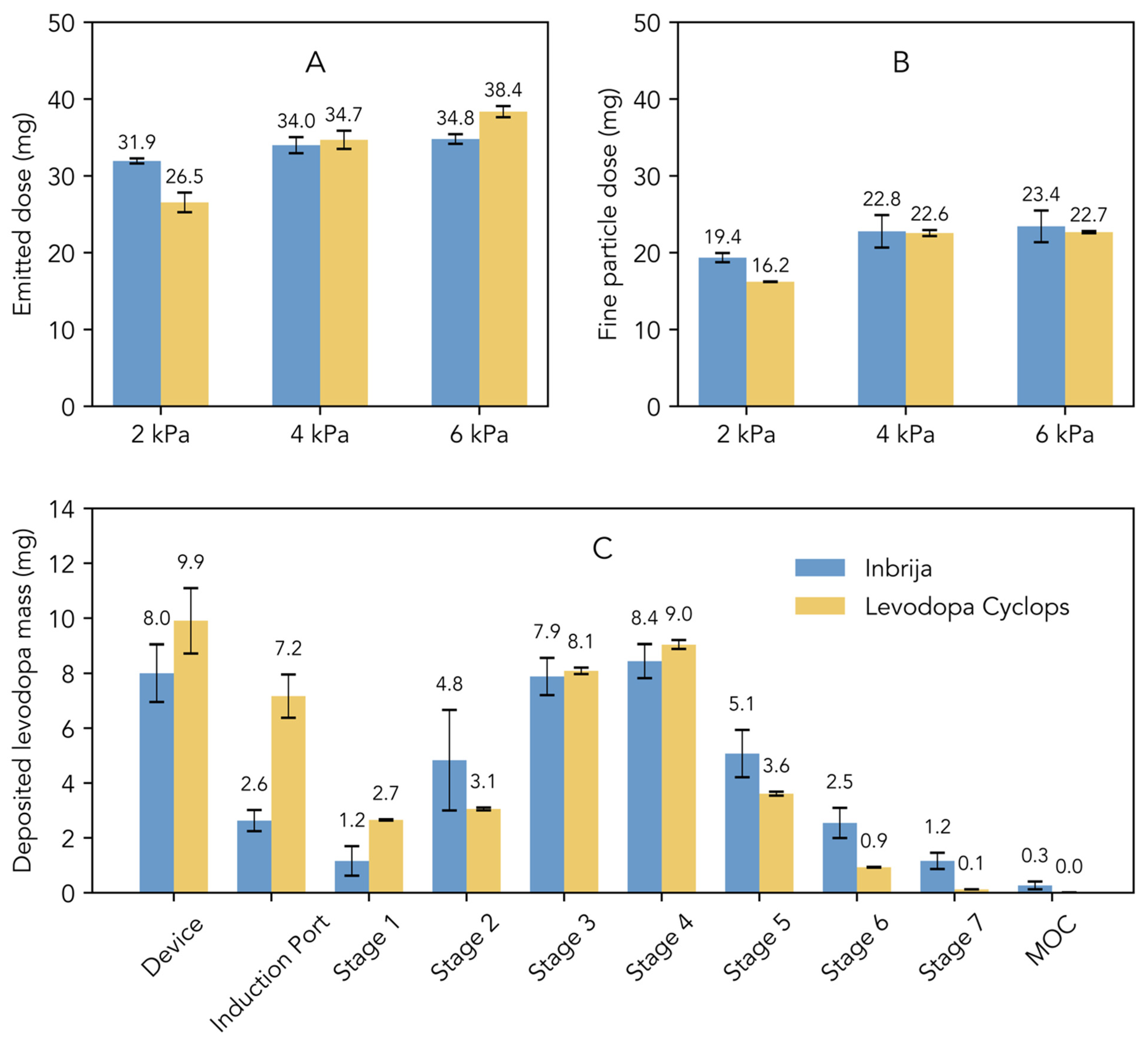
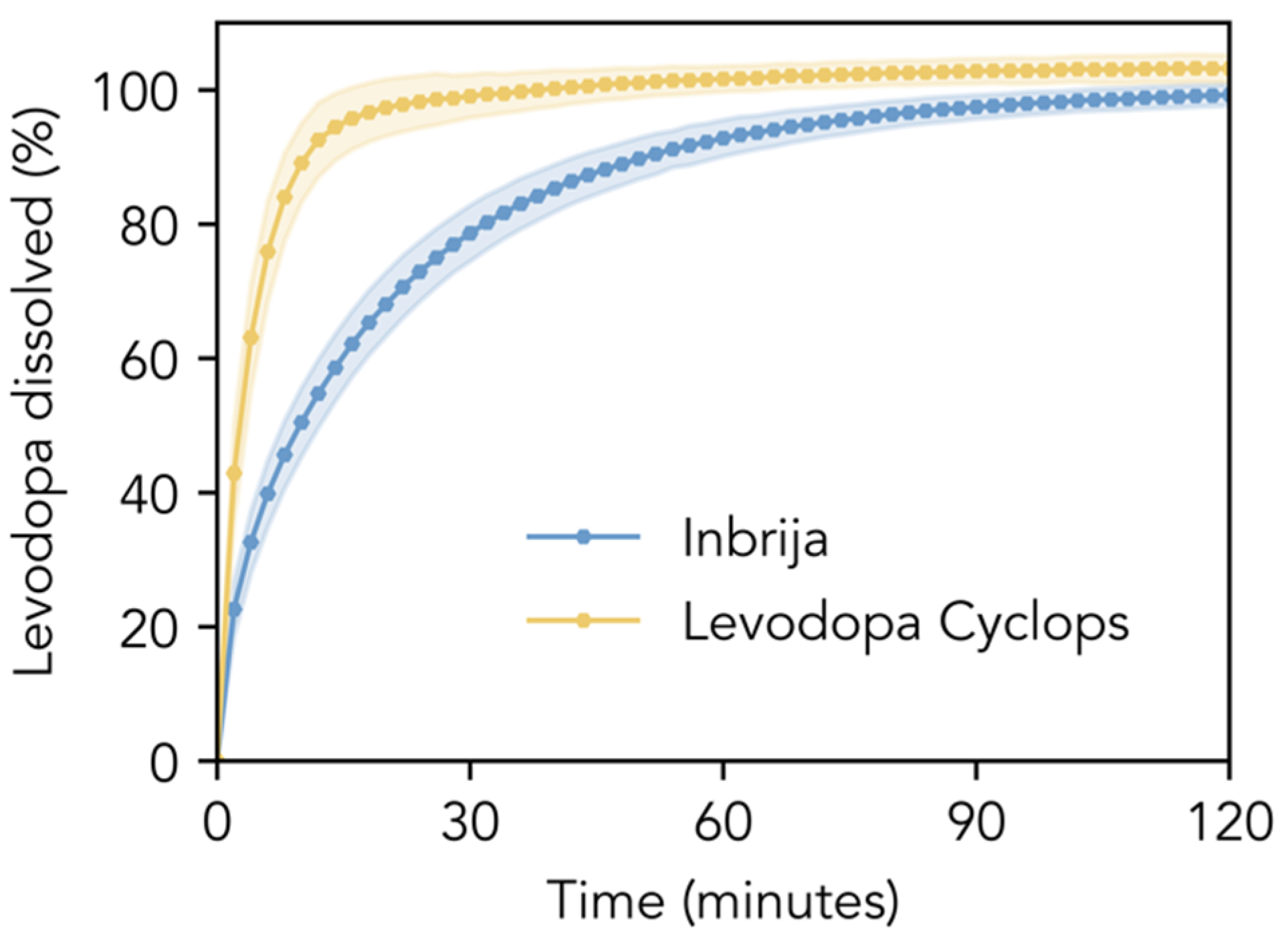
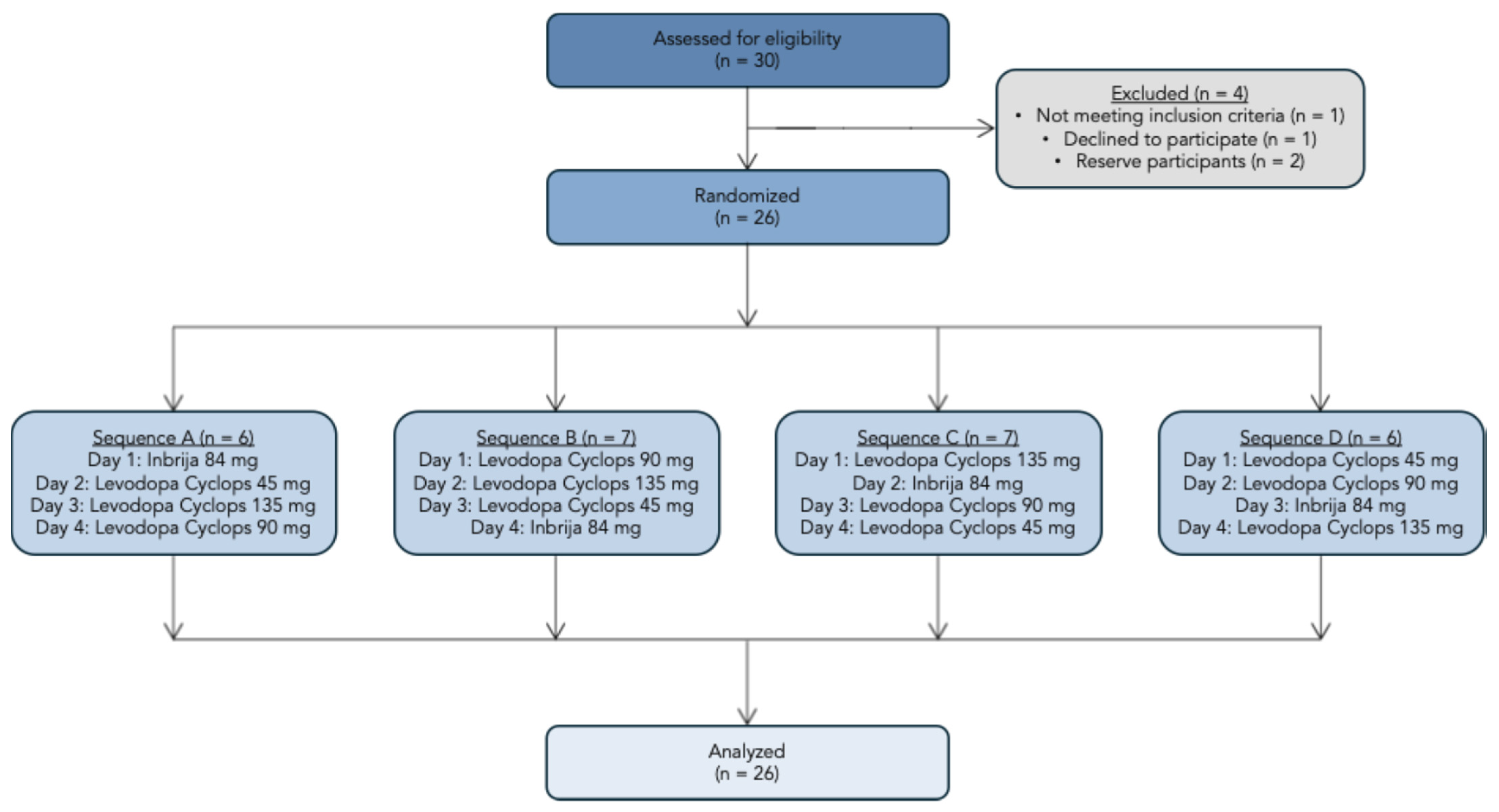
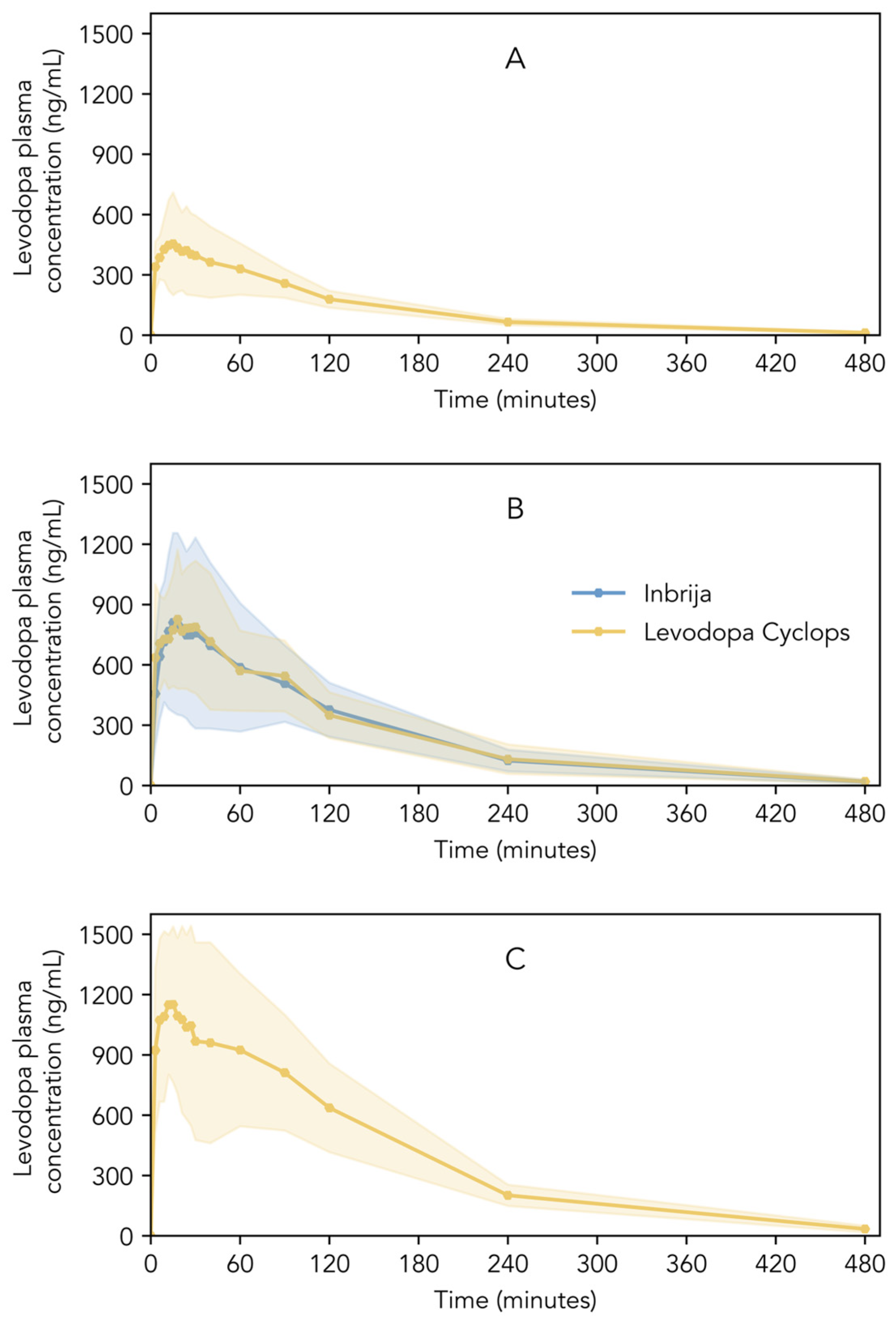
| Inbrija | Levodopa Cyclops | |
|---|---|---|
| Levodopa content | 90% w/w [16] | 98% w/w [13] |
| Excipients | 8% w/w 1,2-dipalmitoyl-sn-glycero-3-phosphocholine (DPPC) and 2% w/w NaCl [16,17] | 2% w/w L-leucine [13] |
| Additional excipients | N/A | Sweeper lactose (lactose 250–315 μm) 1 [18] |
| Powder production method | Spray-drying [19] | Spiral jet-milling [13] |
| Particle morphology 2 | 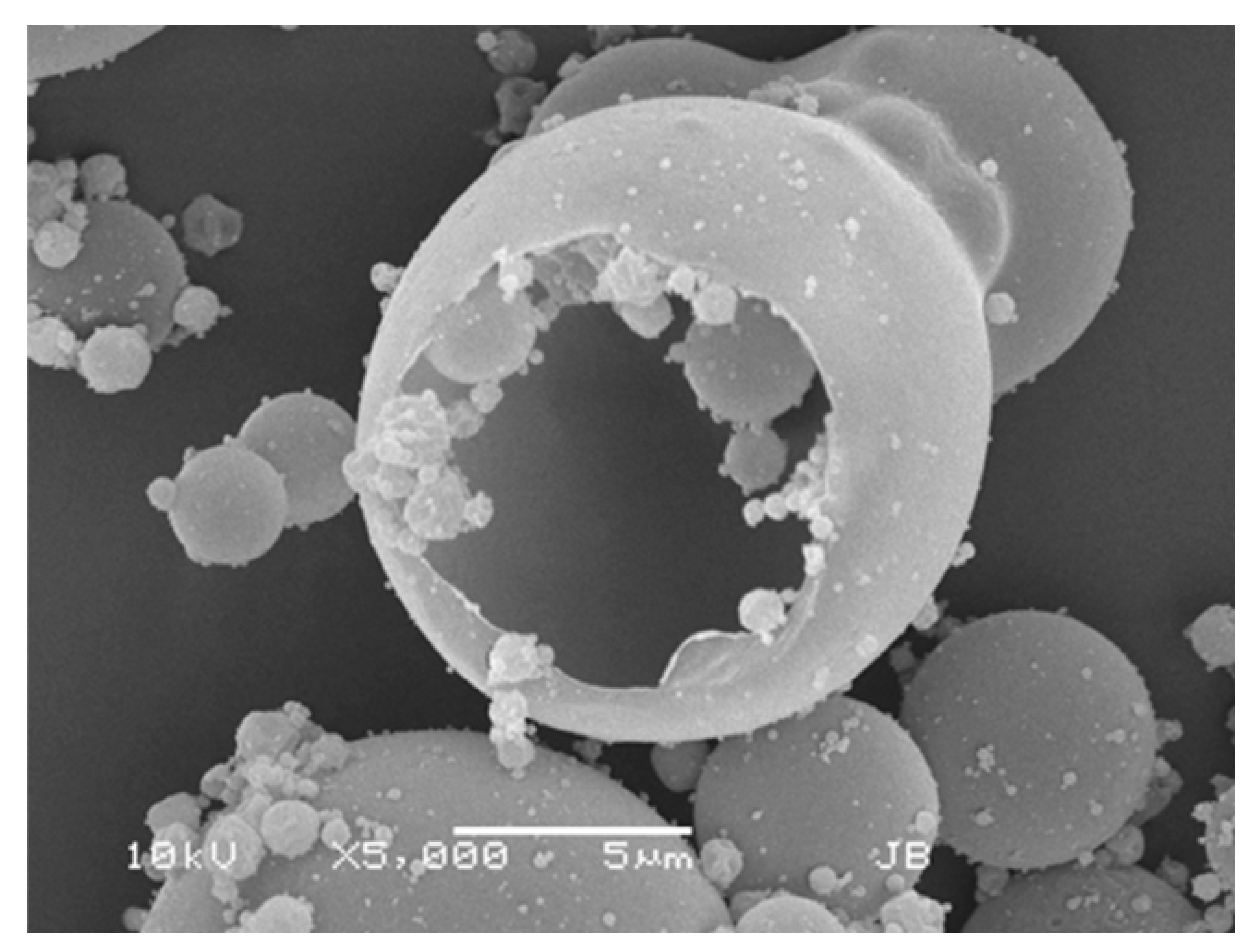 Spherical, hollow particles |  Irregularly shaped, solid particles |
| Inhaler resistance 2 | 0.0671 kPa0.5⋅min⋅L−1 | 0.0390 kPa0.5⋅min⋅L−1 |
| Single-/multiple-use device | Multiple [20] | Single [21] |
| Powder loading | Capsules [20] | Pre-filled dose compartment [21] |
| Dispersion principle | Spinning of the capsule [22] | Air classifier technology [23] |
| Labeled dose | 84 mg per dose (1 dose = 2 capsules) [20] | To be determined |
| Delivered dose | 66 mg per dose (1 dose = 2 capsules) [20] | To be determined |
| Inbrija 84 mg | Levodopa Cyclops 45 mg | Levodopa Cyclops 90 mg | Levodopa Cyclops 135 mg | |
|---|---|---|---|---|
| Cmax (ng/mL) | 1017 (736–1433) | 537 (426–657) | 948 (823–1266) | 1621 (1268–1834) |
| Tmax (min) | 20 (13–40) | 24 (12–31) | 23 (15–38) | 15 (9–29) |
| AUC0–4 (ng⋅h/mL) | 1679 (SD = 500) | 876 (SD = 175) | 1682 (SD = 364) | 2618 (SD = 476) |
| AUC0–t (ng⋅h/mL) | 1955 (SD = 599) | 1032 (SD = 187) | 1976 (SD = 484) | 3091 (SD = 522) |
| AUC0–∞ (ng⋅h/mL) | 2006 (SD = 591) | 1059 (SD = 191) | 2029 (SD = 482) | 3167 (SD = 538) |
| t1/2 (h) | 1.35 (1.28–1.55) | 1.49 (1.40–1.61) | 1.47 (1.37–1.51) | 1.43 (1.33–1.53) |
Disclaimer/Publisher’s Note: The statements, opinions and data contained in all publications are solely those of the individual author(s) and contributor(s) and not of MDPI and/or the editor(s). MDPI and/or the editor(s) disclaim responsibility for any injury to people or property resulting from any ideas, methods, instructions or products referred to in the content. |
© 2025 by the authors. Licensee MDPI, Basel, Switzerland. This article is an open access article distributed under the terms and conditions of the Creative Commons Attribution (CC BY) license (https://creativecommons.org/licenses/by/4.0/).
Share and Cite
Berends, J.M.E.; Wimmenhove, E.J.; Hoppentocht, M.; Hagedoorn, P.; Frijlink, H.W.; Grasmeijer, F. An In Vitro–In Vivo Comparison of Two Levodopa Dry Powder Products for Inhalation: A Randomized Trial Comparing Inbrija and Levodopa Cyclops. Pharmaceutics 2025, 17, 1149. https://doi.org/10.3390/pharmaceutics17091149
Berends JME, Wimmenhove EJ, Hoppentocht M, Hagedoorn P, Frijlink HW, Grasmeijer F. An In Vitro–In Vivo Comparison of Two Levodopa Dry Powder Products for Inhalation: A Randomized Trial Comparing Inbrija and Levodopa Cyclops. Pharmaceutics. 2025; 17(9):1149. https://doi.org/10.3390/pharmaceutics17091149
Chicago/Turabian StyleBerends, Julia M. E., Ettina J. Wimmenhove, Marcel Hoppentocht, Paul Hagedoorn, Henderik W. Frijlink, and Floris Grasmeijer. 2025. "An In Vitro–In Vivo Comparison of Two Levodopa Dry Powder Products for Inhalation: A Randomized Trial Comparing Inbrija and Levodopa Cyclops" Pharmaceutics 17, no. 9: 1149. https://doi.org/10.3390/pharmaceutics17091149
APA StyleBerends, J. M. E., Wimmenhove, E. J., Hoppentocht, M., Hagedoorn, P., Frijlink, H. W., & Grasmeijer, F. (2025). An In Vitro–In Vivo Comparison of Two Levodopa Dry Powder Products for Inhalation: A Randomized Trial Comparing Inbrija and Levodopa Cyclops. Pharmaceutics, 17(9), 1149. https://doi.org/10.3390/pharmaceutics17091149






